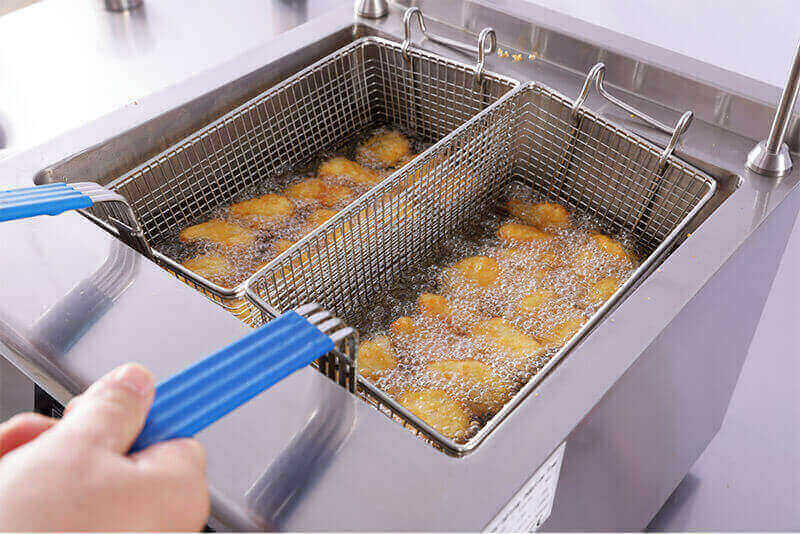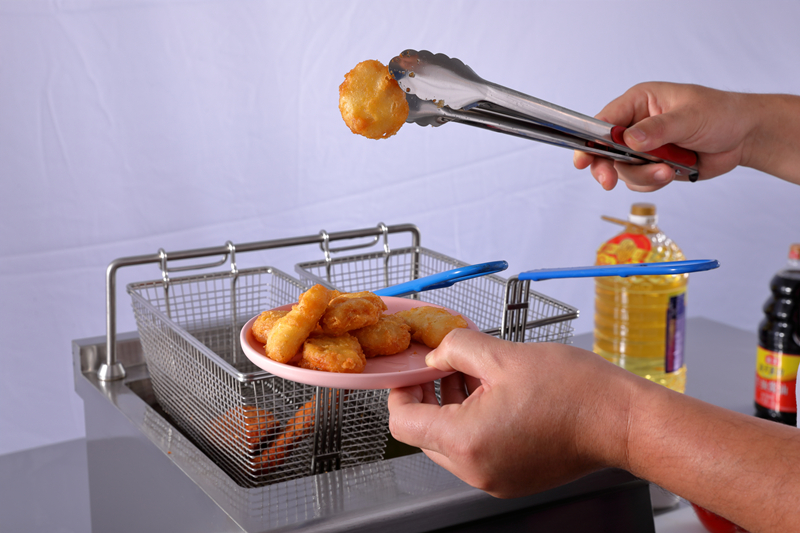In today's fiercely competitive catering industry, an efficient and stable fryer often determines the speed…

Lestov Commercial Induction Deep Fryer – High-Efficiency Solution for Restaurant
In modern commercial kitchens, commercial induction fryers are gradually becoming the catering industry’s new favorite. They are efficient cooking equipment that can provide fast and uniform frying effects, ensure food safety and environmental protection, and are suitable for various catering venues. This article will detail commercial induction fryers’ functions, characteristics, selection points, and maintenance methods.
1. Functions of commercial induction fryers
The primary function of commercial induction fryers is to quickly raise the oil temperature to the required temperature through electromagnetic induction heating technology to fry ingredients rapidly. This fryer can accurately control the oil temperature to ensure that the fried food is crispy on the outside and tender on the inside, golden in color, and has a consistent taste. Its main functions include:
(1) Rapid heating
Electromagnetic induction heating technology can quickly raise the oil temperature to the required temperature, greatly shortening the preheating time.
(2) Accurate temperature control
The built-in temperature sensor monitors the oil temperature in real time to ensure stability within the set range, avoiding inconsistent food quality due to temperature fluctuations.
(3) Automatic smoke exhaust
Equipped with an efficient smoke exhaust system, it can promptly exhaust the oil smoke generated during the frying process to keep the kitchen air fresh.
(4) Timing function
Users can preset the frying time according to different ingredients. The fryer will automatically stop heating after the set time to ensure the food is not overcooked or burnt.
2. Features of commercial induction fryers
(1) High efficiency
The thermal efficiency of electromagnetic induction heating technology is as high as over 90%, which is 30% to 50% more energy-efficient than traditional gas fryers. This reduces not only energy consumption but also operating costs.
(2) Safety
The induction fryer adopts a fully enclosed design to avoid the risk of open flames and high-temperature oil splashing, ensuring the safety of the kitchen staff. At the same time, its automatic power-off protection function can automatically cut off the power supply when an abnormal situation is detected to prevent accidents.
(3) Easy to clean
The fryer’s surface and interior are made of stainless steel, which is easy to clean and maintain. Its detachable design allows users to clean it thoroughly to ensure food safety.
(4) Environmental protection
The induction fryer does not produce open flames and harmful gases during operation, which meets environmental protection requirements. Its efficient smoke exhaust system can reduce oil fume emissions and improve the kitchen environment.
3. Key points for selecting commercial induction fryers
(1) Power and capacity
Choose the appropriate power and capacity according to the kitchen’s usage requirements and the types of fried food. Generally speaking, the greater the power, the faster the frying speed, but the energy consumption is also relatively high. The capacity should be determined according to the kitchen’s production volume to ensure the fryer meets daily needs.
(2) Temperature control
Accurate temperature control is the key to ensuring food quality. Choosing a fryer with a high-precision temperature sensor and automatic temperature control function can ensure stable oil temperature and a consistent taste of fried food.
(3) Safety performance
Safety performance is an essential factor in selecting commercial induction fryers. To ensure safety during use, choose a fryer with multiple safety protection functions, such as automatic power-off protection, overheating protection, and leakage protection.
(4) Brand and after-sales service
Choosing products from well-known brands can ensure the fryer’s quality and performance. At the same time, good after-sales service can provide timely repair and maintenance support when the equipment fails, reducing downtime.
4. Maintenance of commercial induction fryers
(1) Regular cleaning
The fryer should be cleaned regularly to ensure its efficient operation. The frequency of cleaning depends on how often the kitchen is used and the types of fried food. Generally speaking, the surface should be cleaned after daily use, and the oil tank, filter, and exhaust system should be thoroughly cleaned once a week.
(2) Check the electrical connection
Check the fryer’s electrical connection regularly to ensure that the plug and socket are in good contact and not loose or damaged. If any problems are found, they should be repaired or replaced in time.
(3) Replace the filter
The filter is an integral part of the fryer and should be replaced regularly. Depending on usage, it should be replaced every 1-2 weeks to ensure the smooth and efficient operation of the exhaust system.
(4) Check the temperature sensor
The accuracy of the temperature sensor directly affects the fryer’s temperature control. Check the temperature sensor regularly to ensure that it is working correctly. The temperature display should be calibrated or replaced in time if it is inaccurate.
5. Market situation of commercial induction fryers
With the continuous development of the catering industry, the market demand for commercial induction fryers is also increasing. Modern fryers have not only continuously improved in terms of function and performance but also made significant progress in appearance design and intelligence.
For example, some high-end fryers are equipped with intelligent control systems that can remotely monitor and control the equipment’s operating status through mobile phone applications.
6. Future development trends of commercial induction fryers
(1) Intelligence
In the future, commercial induction fryers will be more intelligent. They will have advanced sensors and control systems that automatically adjust the oil temperature and frying time. The fryer can be interconnected with other kitchen equipment through the Internet of Things technology to achieve intelligent management.
(2) Environmental protection
With continuous improvement of environmental protection requirements, fryer environmental performance will receive more attention. Future fryers will adopt more efficient smoke exhaust technology and energy-saving designs to reduce their environmental impact.
(3) Personalization
Fryers will provide more personalized options according to different kitchen needs and decoration styles. From size and shape to color and material, consumers can choose a suitable fryer according to their preferences and kitchen layout.
Conclusion
Commercial induction fryers are necessary equipment in modern kitchens. They can provide fast and uniform frying effects, ensure food safety and environmental protection, and are suitable for various catering venues. Choosing a suitable fryer and performing regular maintenance can ensure its efficient operation and extend the service life of the equipment.
With the continuous advancement of technology, future fryers will be more intelligent, environmentally friendly, and personalized, providing more substantial support for the development of the catering industry.
automatic cooking machine automatic cooking machines bbq chip fryer commercial cooking equipment commercial drop in induction cooker commercial food steamer commercial induction cooker commercial induction cooktop kommersiell induktionsfritös commercial induction fryer commercial induction hob commercial induction soup cooker Kommersiell induktionsångkokare commercial induction wok cooker commercial kitchen cookware food steamer hob induction cooker induction cookware INDUCTION FRYER induction grill induction hob iron wok kitchen equipment repair guide restaurangt equipment restaurant equipment stainless steel cookware user's guidance


This Post Has 0 Comments